Immaculate Conception Emblems
- Spirituality and Devotion
- Marian Symbols
- Liturgy and Mary
- Marian Organizations, Secular and Religious
- Doctrine, Dogma, Theology and Tradition
- Art
- Life of Mary
- Literature
- Research and Resources
- Society and Mary
- World Religions, Ecumenism and Tradition
- Miracles and Apparitions
- Shrines and Churches Associated with Mary
- Bible and Mary
- Music
- Film
- Theater
Immaculate Conception Emblems
Although defined as dogma (1854), the Immaculate Conception is one of those mysteries of Christianity which remain endlessly mysterious, meaning overabundant in significance and inexhaustible as a theme of pious contemplation. Approaching this mystery with the scalpel of cold reasoning only, often leads to its destruction. Generations of Christians in the past understood the danger of domesticating what was ultimately intended to be an expression of God's wonderful and gratuitous love for Mary and through her for each one of us. They sought ways to represent the Immaculate Conception which would circumscribe rather than define the mystery, and therefore used the language of poetry and art.
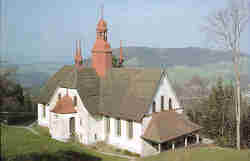
In the sixteenth-eighteenth centuries emblems were an important visual vehicle to express some of Mary's virtues and privileges, in particular that of the Immaculate Conception. The emblem is a symbol which consists of a visual representation of the symbol (pictura) and a mostly Latin inscription (motto, inscriptio). Frequently an explanatory epigram was added. The emblems here presented are from the Hergiswald church in the vicinity of Luzern, Switzerland. The church is small but well known in the region as a Marian shrine and is frequently visited by pilgrims. In 1654 Kaspar Meglinger painted the wooden ceiling. In fact, he filled the ceiling with what is considered as the most extensive and extant program of Marian emblematic. There are altogether 321 emblems which all relate to Mary's person and role.
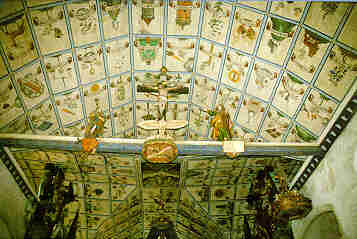
We have selected twelve of them which highlight in a special way Mary's Immaculate Conception. As can be seen, there are many aspects to this mystery:
- Mary is a perfect reflection of God's light
- She is entirely centered on Christ, her Son
- She is the one who crushes the head of the dragon
- In her God's own Son became human
- She makes God visible as "Bride of the Spirit"
- She is eminently graced
- She is the threshold between Old and New Testament
- She is a guide and signpost to Christ
These are but some of the countless symbols celebrating Mary's eminent gracefulness. They are the result of loving and assiduous meditation on Mary's role in Christ's life and ours.
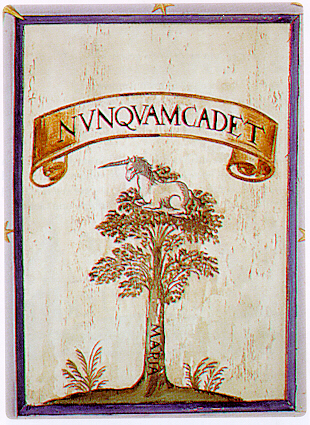
Numquam Cadet - It Will Never Fall - A unicorn is sitting in the crown of a tree which bears the name of Mary. The unicorn stands for Christ who is--like the unicorn--a miracle and mystery of nature, and lets himself be tamed only by a Virgin. The inscription, it will never fall, points to the permanent unity between Christ and his mother. The tree, symbol of Mary, may suggest perseverance and motherly love, more specifically it points out that Mary through her intimacy with Christ and the holiness she derives from him, makes Christ visible and attracts people's attention to him and not to herself.

Numquam Cadet - It Will Never Fall - A unicorn is sitting in the crown of a tree which bears the name of Mary. The unicorn stands for Christ who is--like the unicorn--a miracle and mystery of nature, and lets himself be tamed only by a Virgin. The inscription, it will never fall, points to the permanent unity between Christ and his mother. The tree, symbol of Mary, may suggest perseverance and motherly love, more specifically it points out that Mary through her intimacy with Christ and the holiness she derives from him, makes Christ visible and attracts people's attention to him and not to herself.
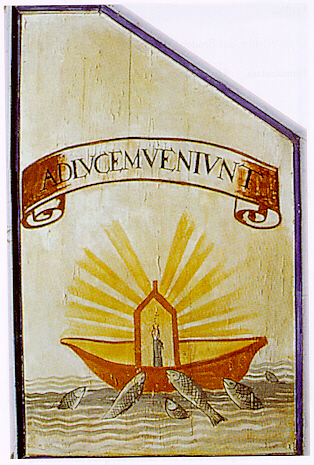
Ad Lucem Veniunt - They Are Seeking the Light - Fish are swimming toward the boat in whose midst a lit lantern has been placed. In Aresis' Imprese sacre this emblem symbolizes discipleship, the apostles following Christ. Here the brightly shining lantern does not refer to Christ but to Mary. The burning candle placed inside the lantern resists wind and thunderstorm. It will not be snuffed out, and therefore becomes a beacon for the many pious souls who are seeking the light. However, the light of the world is Jesus Christ (John 3:21), and thus Mary's light must lead to the very source of her own light which is in God, and became visible in Jesus Christ.

Ad Lucem Veniunt - They Are Seeking the Light - Fish are swimming toward the boat in whose midst a lit lantern has been placed. In Aresis' Imprese sacre this emblem symbolizes discipleship, the apostles following Christ. Here the brightly shining lantern does not refer to Christ but to Mary. The burning candle placed inside the lantern resists wind and thunderstorm. It will not be snuffed out, and therefore becomes a beacon for the many pious souls who are seeking the light. However, the light of the world is Jesus Christ (John 3:21), and thus Mary's light must lead to the very source of her own light which is in God, and became visible in Jesus Christ.
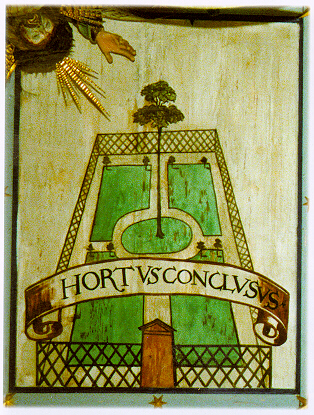
Hortus Conclusus - Enclosed Garden - Mary is compared to the enclosed or closed garden as mentioned in the Canticle of Canticles (4:12). This is one of the oldest symbols of Mary's sinlessness and immaculateness. It was included in the Litanies of Loreto. Since Mary's purity is the equivalent of great beauty, it was the custom in the middle ages and later on to design the enclosed garden as paradise garden filled with flowers and aromatic plants. Here, the garden reflects the Renaissance canon of beauty with its penchant for symmetry and geometric proportions. In its midst we discover a tree, probably in reference to the tree of life, meaning Christ Jesus himself. Mary's love is exclusive. There is room in her heart for Christ alone. Such is the meaning of the enclosed garden. But Jesus is the source of life and love, and thus love springs forth from the heart of Mary and becomes visible and palpable to all who contemplate her enclosed garden, meaning her uniquely dedicated heart.

Hortus Conclusus - Enclosed Garden - Mary is compared to the enclosed or closed garden as mentioned in the Canticle of Canticles (4:12). This is one of the oldest symbols of Mary's sinlessness and immaculateness. It was included in the Litanies of Loreto. Since Mary's purity is the equivalent of great beauty, it was the custom in the middle ages and later on to design the enclosed garden as paradise garden filled with flowers and aromatic plants. Here, the garden reflects the Renaissance canon of beauty with its penchant for symmetry and geometric proportions. In its midst we discover a tree, probably in reference to the tree of life, meaning Christ Jesus himself. Mary's love is exclusive. There is room in her heart for Christ alone. Such is the meaning of the enclosed garden. But Jesus is the source of life and love, and thus love springs forth from the heart of Mary and becomes visible and palpable to all who contemplate her enclosed garden, meaning her uniquely dedicated heart.
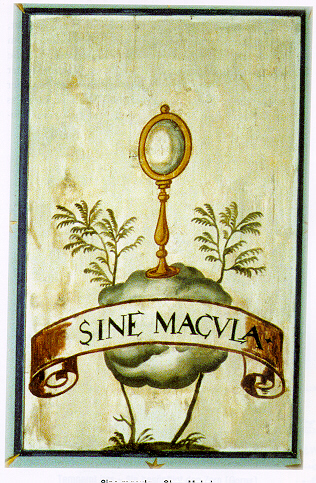
Sine Macula - The Stainless Mirror - A spheric mirror stands on a hovering cloud. The mirror is an old and well known Marian symbol. Here it signifies Mary's sinlessness. This motif has its origin in the Book of Wisdom (7:26): "She is (wisdom) a reflection of the eternal light, and a stainless mirror of God's majesty." (speculum sine macula) The cloud points to Mary's exalted station, and the two decorative trees flanking the mirror are expressions of youth and purity, reaching beyond this life into eternity. This symbol of the Immaculate can be found in Raphael Sadeler's engravings of the Litanies of Loreto (1601/04) and Picinelli's Mondo simbolico. The latter refers to the Song of Songs: "Pulchra es ... macula non est in te." [You are beautiful and there is no stain in you." (4:7)]

Sine Macula - The Stainless Mirror - A spheric mirror stands on a hovering cloud. The mirror is an old and well known Marian symbol. Here it signifies Mary's sinlessness. This motif has its origin in the Book of Wisdom (7:26): "She is (wisdom) a reflection of the eternal light, and a stainless mirror of God's majesty." (speculum sine macula) The cloud points to Mary's exalted station, and the two decorative trees flanking the mirror are expressions of youth and purity, reaching beyond this life into eternity. This symbol of the Immaculate can be found in Raphael Sadeler's engravings of the Litanies of Loreto (1601/04) and Picinelli's Mondo simbolico. The latter refers to the Song of Songs: "Pulchra es ... macula non est in te." [You are beautiful and there is no stain in you." (4:7)]
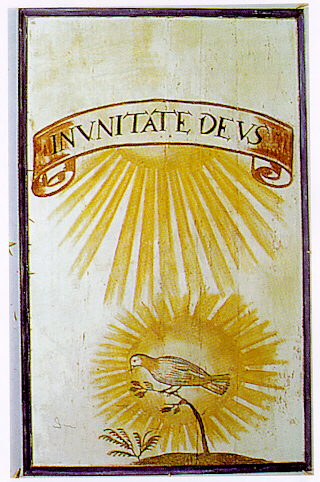
In Unitate Deus - God Is Present in Unity - Reference is made here to Pope Urban VI's coat of arms which shows a dove crowned with the papal tiara. The dove stands for the Spirit who penetrates and unifies the Church. Here, the dove is a symbol of Mary resplendent in virtues of purity, faithfulness, humility and simplicity. The symbol of the Spirit is applied to Mary to signify the great unity between her and the Spirit as announced in Luke 1:34, and sometimes expressed in the designation Bride of the Spirit. God is indeed present in this unity between Mary and the Spirit. The apocryphal gospels speak of Mary cared for like a dove, and Picinelli's Mondo simbolico refers to her as colomba immacolatissima, the most immaculate dove.

In Unitate Deus - God Is Present in Unity - Reference is made here to Pope Urban VI's coat of arms which shows a dove crowned with the papal tiara. The dove stands for the Spirit who penetrates and unifies the Church. Here, the dove is a symbol of Mary resplendent in virtues of purity, faithfulness, humility and simplicity. The symbol of the Spirit is applied to Mary to signify the great unity between her and the Spirit as announced in Luke 1:34, and sometimes expressed in the designation Bride of the Spirit. God is indeed present in this unity between Mary and the Spirit. The apocryphal gospels speak of Mary cared for like a dove, and Picinelli's Mondo simbolico refers to her as colomba immacolatissima, the most immaculate dove.
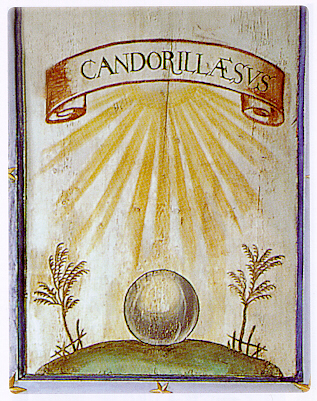
Candor Illaesus - Unadulterated Whiteness - Beams of the shining sun penetrate a crystal ball but do not destroy its immaculateness. A symbol of the Incarnation, this emblem exalts divinity made human (crystal sphere) without harming Mary's integrity and radiant beauty. The virgin remains pure and sinless. Created by Dominico Buoninsegn for the Medici Pope Clemens VII (sphere = characteristic symbol of the Medicis), this emblem was to highlight the personal integrity of the pontiff. Picinelli generalizes the meaning of this symbol and applies it to Mary.

Candor Illaesus - Unadulterated Whiteness - Beams of the shining sun penetrate a crystal ball but do not destroy its immaculateness. A symbol of the Incarnation, this emblem exalts divinity made human (crystal sphere) without harming Mary's integrity and radiant beauty. The virgin remains pure and sinless. Created by Dominico Buoninsegn for the Medici Pope Clemens VII (sphere = characteristic symbol of the Medicis), this emblem was to highlight the personal integrity of the pontiff. Picinelli generalizes the meaning of this symbol and applies it to Mary.
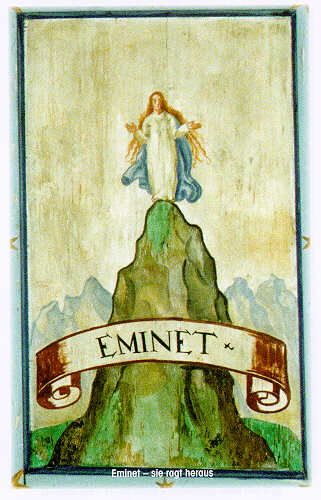
Eminet - She Stands Upright and High - A high and rocky mountain serves as Mary's pedestal. She is the eminent one, elevated by God's special attention and grace, well beyond all other creatures, to be the worthy human mother of the divine son. However, this pro-eminent position does not separate Mary from us. Standing on top of the mountain in a flowing blue mantle she holds her arms and hands open and outstretched toward us. Her immaculateness is a source of special generosity. Her holiness is one of abundant charity whose source is in God.

Eminet - She Stands Upright and High - A high and rocky mountain serves as Mary's pedestal. She is the eminent one, elevated by God's special attention and grace, well beyond all other creatures, to be the worthy human mother of the divine son. However, this pro-eminent position does not separate Mary from us. Standing on top of the mountain in a flowing blue mantle she holds her arms and hands open and outstretched toward us. Her immaculateness is a source of special generosity. Her holiness is one of abundant charity whose source is in God.
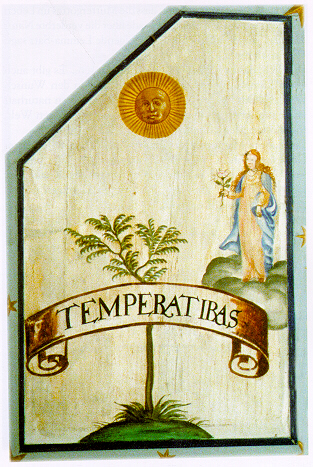
Temperat Iras - She Tempers Wrath - This emblem makes allusion to the passage of the sun from the heat of midsummer to the mild and tempered seasons of late summer and early fall. The sun leaves the the sign of the lion and enters that of the virgin. Picinelli uses this symbol to highlight the passage from the Old to the New Testament. The relationship between the sun and Mary is symbolized in the figure of the virgin clad in red and blue, and holding a bouquet of white flowers in her right hand. It is a sign of her sinlessness and virginity. Mary stands on the threshold of old and new, of heat and tempered atmosphere Mary marks the passage from the reign of despair to that of hope. She bore in her womb the "Sun of Justice," and thus placates or tempers God's ire for having been rejected by the human race.

Temperat Iras - She Tempers Wrath - This emblem makes allusion to the passage of the sun from the heat of midsummer to the mild and tempered seasons of late summer and early fall. The sun leaves the the sign of the lion and enters that of the virgin. Picinelli uses this symbol to highlight the passage from the Old to the New Testament. The relationship between the sun and Mary is symbolized in the figure of the virgin clad in red and blue, and holding a bouquet of white flowers in her right hand. It is a sign of her sinlessness and virginity. Mary stands on the threshold of old and new, of heat and tempered atmosphere Mary marks the passage from the reign of despair to that of hope. She bore in her womb the "Sun of Justice," and thus placates or tempers God's ire for having been rejected by the human race.

Pedem Virginis Timeo - I Dread the Virgin's Foot - The Immaculata is victorious over the dragon symbolizing evil. Her foot--reaching down from heaven--will crush his head. The dragon, Satan, knows it, and therefore expresses his fear: I dread the Virgin's foot. This emblem makes allusion not only to Genesis 3:15 but also to Revelations 12:1 where the snake becomes a dragon ultimately vanquished by the Son of the mother he had persecuted.

Pedem Virginis Timeo - I Dread the Virgin's Foot - The Immaculata is victorious over the dragon symbolizing evil. Her foot--reaching down from heaven--will crush his head. The dragon, Satan, knows it, and therefore expresses his fear: I dread the Virgin's foot. This emblem makes allusion not only to Genesis 3:15 but also to Revelations 12:1 where the snake becomes a dragon ultimately vanquished by the Son of the mother he had persecuted.
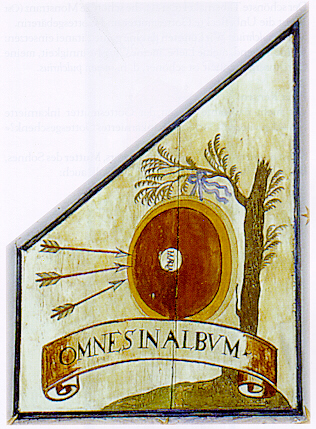
Omnes in Album - They All Reach the White Target - Three arrows are flying toward a target which hangs on a tree trunk. Its center or bull's eye is white, and bears the name of Mary. The white center is a symbol of Mary's purity and Immaculate Conception. The flying arrows may have several meanings: According to Picinelli, they represent evil. This would mean that evil is deflected by the white bull's eye, meaning Mary's sinlessness. Thus, the arrows do not reach the center. However, the inscription tells us that they actually do reach their target. Thus, the meaning here is twofold. It means that the love of God, symbolized in the three theological virtues of faith, hope and charity, will be fully received by Our Lady. The other interpretation sees in the flying arrows the petitions of the people addressed to Mary. They will not miss their target; Mary is our faithful intercessor.

Omnes in Album - They All Reach the White Target - Three arrows are flying toward a target which hangs on a tree trunk. Its center or bull's eye is white, and bears the name of Mary. The white center is a symbol of Mary's purity and Immaculate Conception. The flying arrows may have several meanings: According to Picinelli, they represent evil. This would mean that evil is deflected by the white bull's eye, meaning Mary's sinlessness. Thus, the arrows do not reach the center. However, the inscription tells us that they actually do reach their target. Thus, the meaning here is twofold. It means that the love of God, symbolized in the three theological virtues of faith, hope and charity, will be fully received by Our Lady. The other interpretation sees in the flying arrows the petitions of the people addressed to Mary. They will not miss their target; Mary is our faithful intercessor.
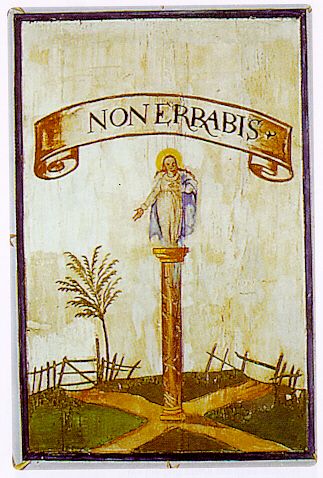
Non Errabis - You Will Not Go Astray - Mary is standing on a column. Her right hand points the way, the right direction. The column is placed in the center of a crossroad. Whoever is watchful enough and lifts his eyes to the figure of Mary will not go astray. The crossroad is a symbol of the cross, our way to salvation. Mary has been placed on this road to point us in the direction of eternal salvation. The column is a sign of exaltation and praise, but also of strength, fearlessness, and perseverance. Several theologians have called Mary columna rectitudinis, the column of rectitude upon which rests the world. Reference is made in this emblem to popular representations of Mary on top of a column, for example, the famous Munich Marian column (1638), and the even older and more famous column with Mary's statue in front of St. Mary Major in Rome (1614).

Non Errabis - You Will Not Go Astray - Mary is standing on a column. Her right hand points the way, the right direction. The column is placed in the center of a crossroad. Whoever is watchful enough and lifts his eyes to the figure of Mary will not go astray. The crossroad is a symbol of the cross, our way to salvation. Mary has been placed on this road to point us in the direction of eternal salvation. The column is a sign of exaltation and praise, but also of strength, fearlessness, and perseverance. Several theologians have called Mary columna rectitudinis, the column of rectitude upon which rests the world. Reference is made in this emblem to popular representations of Mary on top of a column, for example, the famous Munich Marian column (1638), and the even older and more famous column with Mary's statue in front of St. Mary Major in Rome (1614).

Purior Hoc Utroque - Purer Than These Two - The emblem shows two hands: one holding a half filled glass, the other a lily. The inscription purer than those two refers to Mary. Mary is purer than the lily, reputed to be of the most exquisite of all tones of white. Likewise the significance of the glass: its crystal and content are fully transparent, but Mary's immaculateness exceeds its transparency. This emblem stands for the title mater purissima (purest of mothers) in the litany of Loreto.

Purior Hoc Utroque - Purer Than These Two - The emblem shows two hands: one holding a half filled glass, the other a lily. The inscription purer than those two refers to Mary. Mary is purer than the lily, reputed to be of the most exquisite of all tones of white. Likewise the significance of the glass: its crystal and content are fully transparent, but Mary's immaculateness exceeds its transparency. This emblem stands for the title mater purissima (purest of mothers) in the litany of Loreto.
All About Mary includes a variety of content, much of which reflects the expertise, interpretations and opinions of the individual authors and not necessarily of the Marian Library or the University of Dayton. Please share feedback or suggestions with marianlibrary@udayton.edu.
Marian Library
Roesch Library300 College Park
Dayton, Ohio 45469 - 1390 937-229-4214
Website
